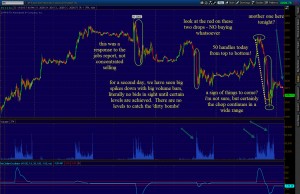We have become accustomed to low volume, low volatility markets. On certain days, you can just feel the intensity and flow potential from the start. Markets gap up and hit morning highs, take a rest and then run hard to finish the day – and all the bulls rejoice. A runaway gap down and followthrough has everyone stumped and waiting for a snapback rally, which may not occur. Bids disappear and prices run hard to finish the days on their lows.
The above scenario has been the mantra so far in 2015, and we just have to get used to it. Sentiment, which has been mostly bullish with the support of the Fed, has started to crack a bit. Perhaps stocks are not the only game in town – bonds continue to attract dollars.
This brings us to a discussion about liquidity, or really a lack thereof. I mostly trade in the equity option markets, and I have found a disturbing trend. Even the most liquid names with multiple market makers are not interested in providing a fair market. Often times, we see very wide bid/ask spreads with no one on the other side of the trade unless you take a horrible price. It’s frustrating when it feels we are getting ripped off. The game of markets is tough enough trying to get on the right side of the trade, but the “games played” make it that much more difficult.
Take Biomarin (BMRN) as an example. This is an upstart biotech firm that is near all-time highs, has had decent stock volume and fair open interest. Certain strikes have had enough interest and activity that the bid/ask prices should be reasonably close. Since this is January, many stocks have enormous liquidity due to the expiration of LEAP options. The January 100 BMRN call this week, just barely out of the money, was sporting a bid/ask spread of .35 x 1.20. This is preposterous for some egregious market maker. If you’re not going make an honest market, then don’t be in the issue.
Perhaps there are not enough shares outstanding for some of these issues, or the floating shares are held tightly in the hands of institutions. That could certainly the case, but it is not an excuse.
The options market is not the only one affected by a lack of liquidity. The futures market, where we see big SPX contracts trade along with e-minis, one of the most liquid of them all – and they often show wide bid/ask spreads and tumbling prices at certain points of the day (see my “dirty bombs” chart below for a recent example). We have heard algorithmic and and high frequency traders claim to provide liquidity, but they suddenly disappear when the balance is tipped. I’m quite surprised there have not been more wide-scale flash crashes due to the games that are played, and I suspect there have been instances where an event of this magnitude was very close.
Commodities are a different beast than options or futures, but we see some of the same problems. The drop in crude oil over the past seven months has been simply amazing. We have seen oil volatility ($OVX) rise sharply – nearly 200% from September 2014. The oil decline has clearly been one-sided, certainly helped by the continued supply from OPEC nations. Yet, in futures contracts, there have been few true bids to balance the market, something not unexpected when a stock/commodity is in free fall. I certainly doubt the price of crude will head straight to zero; there will be a fair price to bring buyers to market, but that may be far off. From a chart perspective any attempt at buying since the break in the low $80’s has been trying to catch a falling knife.
As investors there is a trust that there will be someone on the other side of the trade to provide for liquidity, even in the most dire situations. During the 2008/09 financial crisis, we saw central banks intervene, stepping up to provide the needed liquidity to keep markets in motion. But there are limitations and moral hazard issues there. Liquidity and market-making should come from the public markets, or the trust and belief in our system will be in doubt.
And then where will we be?




















